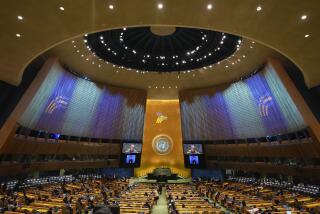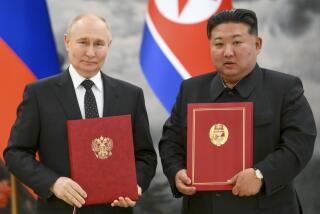India-Pakistan Pact Is Just a First Step
- Share via
Dissimulation--the art of purposeful deception--has long characterized relations between the genetically similar but religiously different peoples of Pakistan and India. This mind-numbing preoccupation with false pretense, twice the cause of border wars over the disputed Himalayan enclave of Kashmir, has driven both to build formidable nuclear war machines while threatening each with financial bankruptcy.
So it was during the inaugural New Delhi-to-Lahore bus trip of Indian Prime Minister Atal Behari Vajpayee to visit Pakistani Prime Minister Nawaz Sharif for the first time in 10 years that South Asians and the world held their collective breath. Was this dissimulation at its maddening worst or the first meaningful sign that stable relations were finally at hand?
In an era where summits are usually held more for their ceremony than substantive negotiations, the promising atmospherics of Lahore went well beyond vagaries and loosely worded commitments contained in the Lahore declaration. The development of trust and mutual self-interest between these two masters of deception may just have laid the groundwork for settling their most vexing bilateral issue: Kashmir.
Underlying their keenness to settle differences, a realization that “regressive incrementalism”--South Asia’s practiced art of shoveling off problems to the next government in the turnstile--had to be replaced by pragmatic collectivism--conflict resolution for the common economic good--to save ravaged economies and dispirited peoples from the irretrievable damage of Western economic and political sanctions.
But translating Lahore’s atmospherics into tangible results will require carefully executing a set of bold political initiatives in which each leader must overcome domestic extremism and the paranoia of the other’s military-industrial complexes to deliver on the ambitious objectives.
They should establish a structural framework with three distinct phases:
* Define the agenda (already completed). India, heretofore adamant that Kashmir was an internal matter, has agreed to place the issue high on the agenda, effectively voiding its claim of wanting to maintain principled Hindu secularism in Muslim-dominated Kashmir. Pakistan has agreed to “move beyond stated positions,” implying a silent retreat on its long-stated demand for holding a plebiscite under U.N. Security Council resolutions to determine Kashmir’s status. Its ideological struggle for Muslim Kashmir, sullied by Islamabad’s support for radical Islamic terrorists in the region, erodes its claim for a democratic solution.
* Demilitarize Kashmir. Islamabad agrees to close both official and unofficial military supply lines and cease financial support for Islamic militants who breath life into the extremist insurgency resident inside Kashmir. This also serves Islamabad well with U.S. anti-terrorism policymakers, fearful that Kashmiri militants might provide safe haven to Osama bin Laden, the alleged mastermind of the U.S. embassy bombings in Africa last year. New Delhi agrees to withdraw troops proportionately to Islamabad’s progress on containing Muslim extremists. This reduces India’s defense burden by more than $3 billion and Pakistan’s by more than $800 million per year.
* Define the boundaries. India agrees to formalize the existing so-called “line of control” as the international boundary separating Pakistan and India, thereby dropping claim to the region presently known as Pakistan-occupied Kashmir and closing the world’s longest standing border dispute. India and Pakistan agree to create a Korea-like demilitarized buffer zone along this line, monitored by an international peacekeeping force in which Kashmiri civilians are free to move about but arms and munitions are not.
Successfully executing the elements of such a peace process could also yield a united South Asian stance on critical international nonproliferation treaties.
But the overarching concern will and should remain economic revitalization. The Clinton administration and other Western powers, having effectively applied subtle but firm economic and political pressure, should now progressively lift all sanctions on both nations--not just in return for movement on the nonproliferation front, but also for movement forward on resolving issues underlying the root cause of proliferation in South Asia.
More than 1 billion people await the courage and vision of the Lahore summiteers to be converted into tangible economic results that stabilize their daily lives--stability that itself is at the very core of transforming South Asia into a strong and vibrant contributor to the world community for the next century.
More to Read
Sign up for Essential California
The most important California stories and recommendations in your inbox every morning.
You may occasionally receive promotional content from the Los Angeles Times.










